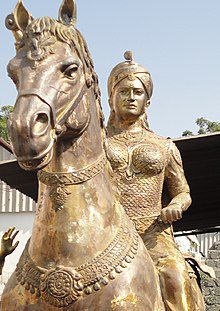Razia Sultan is regarded as the first and the only queen who ruled the Delhi Sultanate. Her achievements and exploits have been praised by historians. She was the first women ruler of the Sultanate who renounced the Purdah system and several other practices that hindered the woman’s personality and character.
Similar to the story of Razia there was another woman queen who ruled around present-day Telangana and was regarded as a fierce warrior. Queen Rudrama Devi and her never-ending tales of glory haven’t got the attention of modern-day historians.

Many of us have read about how Razia Sultan managed her administration and took key measures for the betterment of the empire. The story of Rudrama Devi is similar to Razia just like Razia fought battles, developed policies for efficient administration took key measures for the protection of her people, and also worked for the upliftment of women.
She became so famous that even the Italian traveler Marco Polo who visited her kingdom praised her efforts and generosity which she had shown towards her people.
Queen Rudrama Devi: An Untold Story
Rudrama Devi was the queen of the Kakatiya kingdom which comprised modern-day Telangana and Andhra Pradesh. However, the early history and origin of the Kakatiyas are still ambiguous as nothing can surely be said anything about it.
Initially, it is suggested that the Kakatiyas were originally the feudatories of the western Chalukyas, and later in 1163 when a person named King Ganapatideva made himself the master of the coastal areas of Andhra the Kakatiyas emerged as a significant power. King Ganapatideva ruled from 1199 -1262 CE and had two daughters namely Rudrama and Ganapamba.
During medieval period the widely accepted belief was that a king’s successor should be his son, not his daughter. This was a grim situation for the Kakatiya ruler as he did not have any sons to succeed after him and his empire might collapse. But his prime minister advised him to elect her elder daughter as his successor.

For this, the king performed a century-old ritual which made his daughter to be his successor. After this Queen Rudrama Devi ascended the precious throne of the Kakatiya kingdom in 1259 CE. She was only 16 years old when she took charge of her kingdom. However, as happened to Razai several nobles opposed her and didn’t accept to serve under a woman’s throne.
She was married to the Eastern Chalukyan Prince Virbhadra and had a daughter. However, the great Hindu queen didn’t sit quiet and silenced them when an ideal opportunity came to her. It was in 1263 when Rudrama Devi showed her military prowess to the world.
The king of the Yadavas dynasty Mahadeva tried to extend his influence over the kakatiyas and for this purpose, he led an expedition against Rudrama Devi and her troops. Thinking about the vulnerability of the queen and her troops King Mahadeva was confident enough to defeat the former.
However, the attack led by the Yadavas was staunchly repulsed by the Kakatiyas. The aggression from the queen was so fierce that the Kakatiyas chased the invading army to its capital Devagiri. It is also believed that the queen even ordered to lay siege on Devagiri.
This victory of the queen raised herself as an efficient leader who was always prepared to protect her people and kingdom from any aggressor. Some historians have also suggested that Queen Rudrama Devi wore male attire at her royal court and on the battlefield. This can be regarded as the earliest examples of woman empowerment and women’s emancipation and liberty.
Apart from winning battles she also worked for the betterment of farmers and agriculturalists. She took several key measures to relieve the farmers by building appropriate canals and water reservoirs. She also promoted the use of Telugu literature in her court and also took measures to fortify the fort of Warangal. She also recruited military personnel from non-aristocratic classes which was a liberal attitude of her towards her countrymen.
Note: Do you know that Vijayanagara king Krishnadeva Raya also patronized Telugu??
Read here the fascinating story of Krishnadeva Raya
These efforts made Marco Polo wonder and he praised her and said
The kingdom has been under the rule of a Queen for some 40 years. She is a lady of much discretion who for the great love she bore her husband would never marry another. I can assure you that during all that space of forty years, she administered her realm well. She was a lover of Justice, equity, and peace and was more beloved by those of her kingdom than any lady or lord before.
This praise from an eminent traveler highlights the growing prowess of the great Rudrama Devi. The rule of Rudrama Devi lasted till 1289 CE and it is believed that during her last day, a civil war broke against her led by Ambadeva. She elected Pratapdeva as her successor and tried to curb the rebellions as much as possible. Many believed that she died in a campaign against Ambadeva however the mystery to this day remains unclear.
While many of us focus more on the history of Sultante and their kings and portray them as ideal examples of heroism the unheard story of queens like Rudrama Devi and others still awaits to be told to the general public.
LIKE WHAT WE ARE DOING? DONATE TO DHARMAYUDH
If you support what we are doing and would like to contribute to help us grow and reach more Indians to teach them more about such forgotten historic Indian Heroes and stories, please consider donating any amount. It will help us grow.

